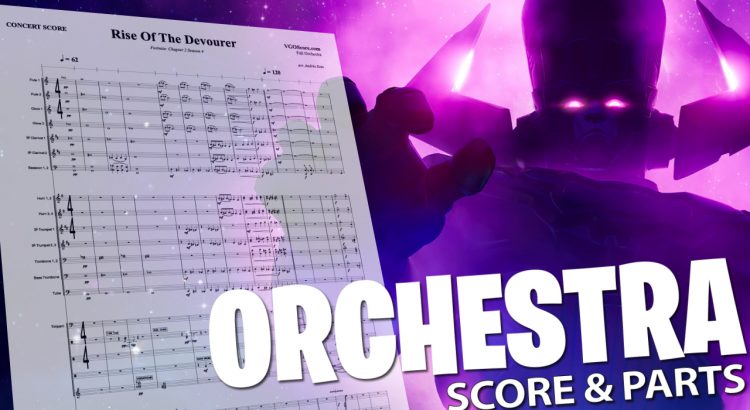Rise Of The Devourer
from Fortnite Season 2 Chapter 4
Composer: Epic Games Arrangement: Andrés Soto
“Rise of the Devourer” from Fortnite Season 2 Chapter 4, a piece that originally resonates with the game’s expansive and dynamic narrative landscape. This composition, set against the backdrop of one of the game’s most climactic events, embodies the essence of anticipation, suspense, and the exhilarating rush of battle. The task of reorchestrating this piece for a symphonic orchestra offered a unique set of challenges and opportunities to explore the depth and versatility of orchestral music while staying true to the spirit of the original composition.
Analyzing “Rise of the Devourer”
“Rise of the Devourer” is notable for its intense, driving energy and its ability to encapsulate the essence of the moment it represents in Fortnite. The original piece leverages a blend of electronic elements, percussive beats, and orchestral swells to create a sense of impending doom and the monumental effort required to confront it. The music plays a pivotal role in immersing players in the game’s narrative, heightening the tension and excitement of the gameplay experience.
The Composer and Original Context
The original composers of Fortnite’s music have consistently demonstrated a knack for crafting scores that enhance the gaming experience, providing players with an auditory backdrop that complements the visual and interactive elements of the game. “Rise of the Devourer” is no exception, serving as a testament to the composers’ ability to convey complex emotional narratives and augment the player’s engagement with the game world.
Challenges of Reorchestration
Reorchestrating “Rise of the Devourer” for a symphonic orchestra involved several significant challenges:
- Translating Electronic Elements: One of the primary challenges was translating the original’s electronic and synthesized elements into acoustic orchestral textures. This required not only a creative approach to instrumentation but also a deep understanding of orchestral colors to maintain the piece’s energy and intensity.
- Capturing Dynamic Energy: The original composition is characterized by its dynamic shifts and driving rhythms. Replicating this energy in an orchestral setting necessitated innovative use of the orchestra’s percussive and rhythmic capabilities, ensuring that the piece retained its momentum and impact.
- Conveying Narrative Depth: Given the piece’s narrative significance in the game, it was crucial to ensure that the orchestral arrangement conveyed the same sense of story and emotion. This involved careful thematic development and orchestral texturing to mirror the original composition’s ability to tell a story.
- Adapting to Orchestral Dynamics: The shift from a synthesized score to an orchestral arrangement also involved adapting the music to fit the dynamic range and expressive capabilities of a symphony orchestra. This meant reimagining the piece’s climactic moments and subtleties in a way that could be naturally expressed by orchestral instruments.
Conclusion
The process of reorchestrating “Rise of the Devourer” for a symphonic orchestra was a deeply rewarding endeavor that highlighted the adaptability and expressive power of orchestral music. By addressing the challenges of translating electronic elements, capturing the original’s dynamic energy, and conveying the piece’s narrative depth within an orchestral framework, the arrangement not only pays homage to the original composition but also offers a new perspective on its musical themes.
Download PDF: Patreon
Download XML editable file: Patreon

